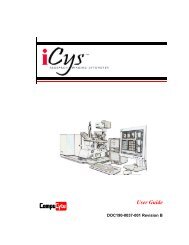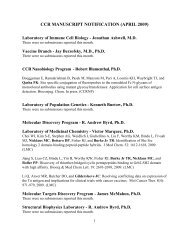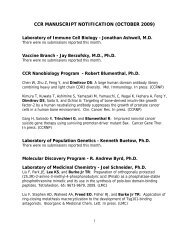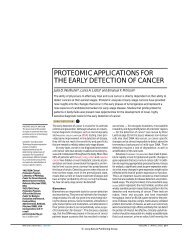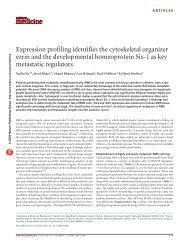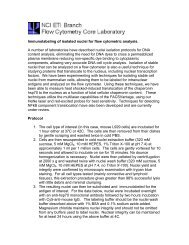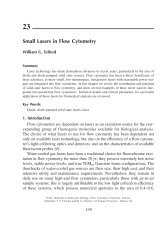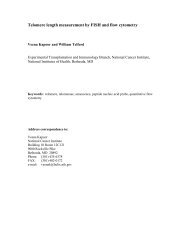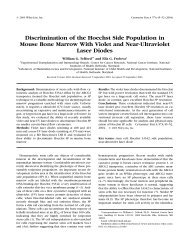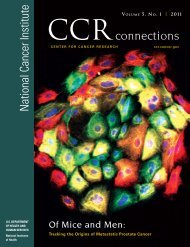Practical Analysis of Stem Cells by Flow Cytometry - National ...
Practical Analysis of Stem Cells by Flow Cytometry - National ...
Practical Analysis of Stem Cells by Flow Cytometry - National ...
Create successful ePaper yourself
Turn your PDF publications into a flip-book with our unique Google optimized e-Paper software.
<strong>Practical</strong> <strong>Analysis</strong> <strong>of</strong> <strong>Stem</strong> <strong>Cells</strong><br />
<strong>by</strong> <strong>Flow</strong> <strong>Cytometry</strong><br />
Established Methods and Emerging Technologies<br />
Bill Telford<br />
Experimental Transplantation and Immunology Branch<br />
<strong>Flow</strong> <strong>Cytometry</strong> Laboratory<br />
<strong>National</strong> Cancer Institute<br />
<strong>National</strong> Institutes <strong>of</strong> Health
<strong>Flow</strong> <strong>Cytometry</strong> in <strong>Stem</strong> Cell Biology<br />
<strong>Flow</strong> cytometry and cell sorting are absolutely indispensable techniques<br />
for both the identification and isolation <strong>of</strong> embryonic and adult stem cells<br />
in both bone marrow and other tissues.<br />
• Fluorescent immunophenotyping for stem cell markers<br />
• Aldehyde dehydrogenase activity detection using<br />
fluorogenic substrates<br />
• G0/G1 discrimination using Hoechst 33342/pyronin Y<br />
• Hoechst side population analysis
Quiescent SC<br />
CD34-c-Kit+<br />
CD34-c-Kit-<br />
Self-renewal<br />
Turnover time: 30-60 days<br />
<strong>Stem</strong> cell subpopulations and their identification<br />
Hematopoetic stem cells (HSCs)<br />
Circulating CD34+ <strong>Stem</strong> Cell<br />
Activated SC CD34+ c-Kit -<br />
Self-renewal<br />
More frequent turnover<br />
CD34+ c-Kit+<br />
Progenitor Cell<br />
Immature<br />
differentiating<br />
cells<br />
From DS Donnely DS and Krause DS, Leukemia and Lymphoma, 40, 221-234 (2001)
Isolation <strong>of</strong> <strong>Stem</strong> <strong>Cells</strong> <strong>by</strong> <strong>Flow</strong> <strong>Cytometry</strong><br />
As with most things in biology, there is no single characteristic<br />
that adequately identifies stem cells <strong>by</strong> itself.<br />
We need to look at multiple phenotypic characteristics including<br />
cell surface markers and biochemical / physiological characteristics.<br />
And, if possible, we need to look at these multiple characteristics<br />
in a single multiparametric assay.<br />
And <strong>of</strong> course, flow cytometry is an ideal way to do this!
Bone Marrow Cell Differentiation <strong>by</strong> Scatter Measurement<br />
SSC<br />
R1<br />
R5<br />
mature<br />
lymphocytes<br />
(CD3/B220)<br />
RBCs<br />
(Ter119)<br />
granulocytes/monocytes<br />
(Gr-1/Mac-1)<br />
R2<br />
R4<br />
FSC<br />
R3<br />
stem cells / progenitors
Phenotypic markers for mammalian hematopoetic stem cells<br />
• Human stem cells<br />
• Lineage depletion<br />
• CD34<br />
• HLA-DR<br />
• AC133 (CD133)<br />
• CD7<br />
• Rodent stem cells<br />
• Lineage depletion<br />
• CD34<br />
• Sca-1<br />
• c-kit (CD117)<br />
• MAC-1 (+/-)
Phenotypic markers for mammalian stem cells<br />
CD34<br />
• A single chain transmembrane glycoprotein expressed on HSCs,<br />
vascular endothelium, embryonic fibroblasts and some cells<br />
in fetal and adult nervous tissue<br />
• Promotes adhesive interactions between stem cells and stromal<br />
elements in the bone marrow<br />
• Probably regulates association between stems cells and the “niche”<br />
microenvironment via indirect regulation <strong>of</strong> other adhesion factors<br />
• The dominant marker for clinical identification and separation <strong>of</strong><br />
stem cells
Phenotypic markers for mammalian stem cells<br />
Sca-1<br />
• <strong>Stem</strong> cell antigen, a GPI-linked surface protein expressed on 30% <strong>of</strong><br />
mouse bone marrow including pluripotent HSC and committed<br />
lymphoid and myeloid progenitors, also was found in osteoblasts<br />
kidney apithelia(Ly-6A/E).<br />
• HSCs from Sca-1 KO mice have impaired repopulation potential.<br />
• Lower engraftment <strong>of</strong> secondary transplants in Sca-1 deficient<br />
animals also suggests a defect in HSC self-renewal.<br />
• In addition to HSC deficiencies in Sca-1-deficient mice, specific cell<br />
lineages and progenitor subpopulations are also affected. (Ito CY,<br />
Li CY, Bernstein A, Dick JE, Stanford WL. Blood 101, 517-23, 2002).
Phenotypic markers for mammalian stem cells<br />
c-kit (steel factor)<br />
• Transmembrane glycoprotein, PTK-R in HSC, was found in<br />
melanocytes and primordial germ cells<br />
• Mice lacking the receptor tyrosine kinase c-Kit (c-Kit W/W ) have<br />
hematopoietic defects causing perinatal death<br />
• A viable c-Kit W/W mouse shows an age-dependent, progressive<br />
decline <strong>of</strong> pro-T and pro-B cells accompanied <strong>by</strong> loss <strong>of</strong> common<br />
lymphoid progenitors in the bone marrow in adult mice lacking c-kit.<br />
• Adult c-KitW/W hematopoietic stem cells can engraft in host bone<br />
marrow but fail to radioprotect, form spleen colonies, or establish<br />
sustained lymphopoiesis (Waskow C, Paul S, Haller C, Gassmann<br />
M, Rodewald H., Immunity 3, 277-88, 2003)
Benchtop analyzers<br />
• BD FACScan – one laser, three colors<br />
• BD FACScalibur – two lasers, four colors<br />
• Beckman Coulter EPICS XL – one laser<br />
four colors
Sca-1 and c-kit expression in mouse bone marrow<br />
Three color analysis<br />
antibodies against B220, CD3, Ly6C+G,<br />
GR-1, Ter119, CD5 and NK1.1<br />
FITC “dump” channel<br />
FITC-lineage Lineage depletion with biotinylated<br />
APC-c-kit<br />
APC-C-kit<br />
c-kit only<br />
APC-anti-c-kit<br />
PE-Cy5-anti-Sca-1<br />
FITC-Lineage<br />
PE-Cy5-Sca-1<br />
Sca-1<br />
only
Sca-1, c-kit and CD34 expression in mouse bone marrow<br />
Four color analysis<br />
PE-Cy7 labeling for lineage panel<br />
(CD3, B220, Ly6C + G, CD11b, Ter119, NK1.1, CD5)<br />
side scatter<br />
PE-Cy7-Lineage<br />
PE-Cy5.5-Sca-1<br />
side scatter<br />
forward scatter forward scatter<br />
FITC-c-kit<br />
PE-CD34<br />
FITC-c-kit<br />
PE-CD34<br />
PE-Cy5-Sca-1<br />
PE-Cy7-Lineage<br />
side scatter
Discrimination <strong>of</strong> the Hoechst SP<br />
on the flow cytometer<br />
• When loaded with the fluorescent<br />
DNA dye Hoechst 33342, murine<br />
bone marrow stem cells preferentially<br />
pump out the dye via the ABCG2<br />
membrane transporter.<br />
Samples from Drs. Atsushi Terasumi and John Vogel, DB, NCI, NIH<br />
Mouse L929<br />
Hoechst 33342 2 :g/ml<br />
• These “side population” (SP) cells can be distinguished on<br />
the basis <strong>of</strong> their reduced Hoechst dye fluorescence<br />
(Goodell et al., JEM 183, 1797 (1996)).<br />
• Both DNA-bound (Hoechst blue fluorescence) and unbound<br />
(Hoechst red fluorescence) used to distinguish side<br />
population cells.<br />
• SP cells are enriched for Sca-1 expression and show no<br />
lineage marker expression. SP cells can reconstitute<br />
irradiated mice with both lymphoid and myeloid lineages.<br />
Hoechst 33342 Blue (440/10)<br />
Murine bone marrow<br />
unseparated<br />
(150,000 events)<br />
0.04%<br />
Hoechst 33342 Red<br />
(675/20 nm)
BD FACSVantage SE
Discrimination <strong>of</strong> the Hoechst SP on the flow cytometer<br />
Mouse L929<br />
Hoechst 33342 2 :g/ml<br />
HO<br />
blue<br />
440/10<br />
675/20<br />
HO<br />
red<br />
split mirror<br />
krypton-ion<br />
UV (tertiary)<br />
laser path<br />
argon-ion 488 nm<br />
(primary)<br />
laser path
Hoechst 33342 Blue (440 nm)<br />
Verapamil blocks the accumulation <strong>of</strong> Hoechst SP cells<br />
no verapamil<br />
no prior<br />
enrichment<br />
0.11%<br />
Samples from Drs. Atsushi Terasumi and John Vogel, DB, NCI, NIH<br />
Hoechst 33342 Red (675 nm)<br />
verapamil 10 :M<br />
30 m preincubation<br />
no prior<br />
enrichment<br />
0.03%
Negative selection <strong>of</strong> lineage-positive cells <strong>by</strong> magnetic bead depletion<br />
Label bone marrow with hapten<br />
or PE-conjugated antibodies<br />
against lineage markers<br />
CD3<br />
B220<br />
Ly6C + G<br />
Gr-1<br />
Ter119<br />
NK1.1<br />
CD5 PE
Hoechst 33342 Blue (440 nm)<br />
Discrimination <strong>of</strong> Hoechst SP on the flow cytometer<br />
Lineage panel includes CD3, B220,<br />
CD11b, Ly6G, Ter-119<br />
Murine bone marrow<br />
Lineage+ antibody column<br />
flow through cell fraction<br />
Samples from Drs. Paul Love and Ella Frolova, NICHD, NIH<br />
Hoechst 33342 Red (675 nm)<br />
Murine bone marrow<br />
Lineage+ antibody<br />
retained fraction
HO<br />
blue<br />
Discrimination <strong>of</strong> Hoechst SP on the flow cytometer<br />
440/10<br />
675/20<br />
HO<br />
red<br />
It is very possible (and highly desirable) to combine Hoechst SP<br />
analysis and cell surface immunophenotyping.<br />
split mirror<br />
krypton-ion<br />
UV (tertiary)<br />
laser path<br />
argon-ion 488 nm<br />
(primary)<br />
laser path<br />
Lin<br />
575/26<br />
Sca-1<br />
530/30<br />
560 SP<br />
Lineage “dump” channel<br />
(CD3, B220, Ly6C + G,<br />
CD11b, Ter119, NK1.1,<br />
CD5)
Hoechst 33342 Blue (440 nm)<br />
Murine bone marrow<br />
Lineage+ antibody column<br />
flow through cell fraction<br />
Lineage marker expression in Hoechst SP cells<br />
Hoechst 33342 Red (675 nm)<br />
<strong>Cells</strong> with increasing SP phenotype<br />
show decreased Lin expression<br />
Lin expression<br />
Lin+ fraction
Lineage exclusion and Hoechst SP<br />
analysis in mouse bone marrow<br />
PE-Cy7-Lineage<br />
side scatter<br />
PE-Cy7 labeling for lineage panel<br />
(CD3, B220, Ly6C + G, CD11b, Ter119,<br />
NK1.1, CD5)<br />
all<br />
cells<br />
lineage<br />
negative<br />
Lineage exclusion enriches for stem cells, but is insufficient alone for good isolation.
Hoechst 33342 Blue (440 nm)<br />
Murine bone marrow<br />
Lineage+ antibody column<br />
flow through cell fraction<br />
Sca-1 expression in SP subpopulation cells<br />
Hoechst 33342 Red (675 nm)<br />
<strong>Cells</strong> with increasing SP phenotype<br />
are enriched for Sca-1 expressing cells<br />
4.2%<br />
6.5%<br />
25.3%<br />
63.9%<br />
Sca-1 expression
Lineage exclusion, Sca-1 and c-kit<br />
immunophenotyping in mouse bone<br />
marrow Hoechst SP analysis<br />
APC-C-kit<br />
c-kit only<br />
PE-Cy5-Sca-1<br />
PE-Cy7 labeling for lineage panel<br />
(CD3, B220, Ly6C + G, CD11b, Ter119,<br />
NK1.1, CD5)<br />
Sca-1<br />
only<br />
all<br />
cells<br />
lineage<br />
negative<br />
lineage<br />
negative<br />
Sca-1+<br />
c-kit+
Hoechst 33342 Blue (440 nm)<br />
Lineage panel includes CD3, B220,<br />
CD11b, Ly6G, Ter-119<br />
Murine bone marrow<br />
Lineage+ antibody column<br />
flow through cell fraction<br />
unsorted<br />
Sorting Hoechst SP cells<br />
Hoechst 33342 Red (675 nm)<br />
Murine bone marrow<br />
Lineage+ antibody column<br />
flow through cell fraction<br />
sorted
Tissue and species distribution <strong>of</strong> the Hoechst SP phenotype<br />
A wide variety <strong>of</strong> stem cell types<br />
(hematopoetic and mesenchymal,<br />
embryonic and adult) from both<br />
non-primate and primate tissues<br />
exhibit some degree <strong>of</strong> ABC<br />
dependent SP activity.<br />
Mouse BM<br />
Monkey BM<br />
Mouse skeletal-muscle cells<br />
Mouse ES
Laser sources on the FACSVantage SE<br />
argon-ion<br />
HeNe<br />
krypton-ion
Equipment required for analysis <strong>of</strong> Hoechst side population…<br />
• Large scale cell sorter (i.e. FACSVantage DiVa,<br />
Beckman-Coulter Altra or Cytomation MoFlo<br />
• High power argon-ion or krypton-ion laser (US$ 30,000)<br />
• Total equipment cost = US$ 400,000<br />
The equipment for analyzing Hoechst SP is prohibitively<br />
expensive for most institutions.
Polychromatic flow cytometers<br />
• BD LSR II, Beckman-Coulter FC500,<br />
Cytomation CyAn<br />
• Polychromatic cell sorting using a<br />
variety <strong>of</strong> laser sources<br />
• Up to 10 colors simultaneously using<br />
up to four lasers<br />
Blue-green 488 nm laser<br />
detector<br />
configuration
BD Biosciences LSR II<br />
Laser sources<br />
HeNe 633 nm (red)<br />
Diode-pumped solid state<br />
488 nm (blue-green)<br />
VLD 408 nm (violet)<br />
Near-UV laser diode 374 nm
Novel laser sources for flow cytometry<br />
• Laser diodes<br />
• Near-infrared and red<br />
• Blue<br />
• Violet<br />
• Near-ultraviolet<br />
• Diode-pumped solid state<br />
• Diode pumping <strong>of</strong> a solid state laser medium (such as yttrium<br />
aluminum garnet (YAG), or neodymium-YAG<br />
• Frequency doubling or tripling <strong>of</strong> can generate interesting<br />
laser lines for flow cytometry<br />
• DPSS green 532 nm<br />
• DPSS blue-green 460 – 490 nm<br />
• Mode-locked Nd-YAG frequency-tripled 355 nm UV laser<br />
(quasi-CW)
Hoechst blue fluorescence (450/50)<br />
Lightwave mode-locked Nd-YAG 355 nm laser<br />
NdYag 355 nm 22 mW<br />
BD LSR II<br />
Hoechst red fluorescence (650 LP)<br />
Cost is still high (about US$ 30,000)
Laser diodes<br />
Laser diodes currently cover the infrared<br />
to the near-ultraviolet, with a few critical<br />
gaps.<br />
InGaAsSb/<br />
Ga/Sb<br />
2500<br />
InGaAsP/InP<br />
1240<br />
InGaAs/GaAs<br />
830<br />
AlGaAs/GaAs<br />
Wavelength (nm)<br />
InGaP/GaAs<br />
red/<br />
near-IR<br />
diodes<br />
620<br />
visible range<br />
“orange gap”<br />
InGaN/Al 2 O 3<br />
blue/violet/<br />
near-UV<br />
diodes<br />
420
Single Transverse Mode Violet Laser Diode<br />
• can emit from 397 to 408 nm<br />
• may provide a useful near UV laser<br />
source for both flow and laser<br />
scanning cytometry
Violet lasers on benchtop flow cytometers<br />
• Solid-state violet laser diodes (VLDs) are now<br />
standard equipment on a wide variety <strong>of</strong> flow<br />
cytometers<br />
BD LSR II<br />
• BD LSR II and FACSAria<br />
• DakoCytomation CyAn<br />
• Compucyte LSC2 and iCys<br />
• These small, reliable laser sources have<br />
broadened the use <strong>of</strong> violet-excited<br />
fluorochromes such as DAPI, Cascade Blue<br />
and Pacific Blue.<br />
BD FACSVantage SE<br />
Violet laser diode 405 nm 18 mW
Hoechst SP <strong>Analysis</strong> using a Violet Laser Diode<br />
Power Technology 408 nm 15 mW<br />
Hoechst 33342 Blue (440 nm)<br />
Kr MLUV 100 mW<br />
FACSVantage DiVa<br />
Hoechst 33342 Red (675 nm)<br />
Violet laser diode 408 nm<br />
BD LSR II<br />
Murine bone marrow<br />
No purification<br />
Violet laser diodes allow detection <strong>of</strong> the SP population,but with very low resolution.
Spectral Properties <strong>of</strong> Hoechst 33342<br />
CH 3 +NH<br />
Hoechst 33342<br />
N<br />
Relative fluorescence<br />
N<br />
NH+<br />
Cl<br />
N<br />
NH+<br />
450/50<br />
300 350 400 450 500 550 600 650<br />
O<br />
H<br />
Wavelength (nm)<br />
The spectra <strong>of</strong> Hoechst<br />
33342 suggests that it<br />
would be poorly excited<br />
<strong>by</strong> violet laser light.<br />
Hoechst 33342
Hoechst SP <strong>Analysis</strong> using a Violet Laser Diode<br />
Violet diode 408 nm 25 mW<br />
mouse BM<br />
no<br />
separation<br />
mouse BM<br />
lineage<br />
depletion<br />
(SC-enriched)<br />
no inhibitor fumitremorgin C<br />
SP = 1.58% SP = 0.58%<br />
SP = 5.72%<br />
Hoechst red<br />
SP = 0.28%<br />
Hoechst blue<br />
APC-c-kit<br />
0.31%<br />
2.14%<br />
FITC-Sca-1<br />
Sca-1 (+) c-kit (+)<br />
gated cells<br />
SP = 76.5%<br />
SP = 65.8%<br />
Hoechst red<br />
Violet laser diodes allow detection <strong>of</strong> the SP population,but with very low resolution.<br />
Hoechst blue
Is good Hoechst SP resolution necessary?<br />
Yes, it is!<br />
Hoechst 33342 labeled<br />
bone marrow <strong>of</strong>ten<br />
produces more than<br />
one hypodlploid population.<br />
We aren’t sure what these<br />
low-blue populations are,<br />
but they are NOT stem cells.<br />
This is especially true <strong>of</strong><br />
primate bone marrow and<br />
non-hematopoetic<br />
tissues.<br />
Suboptimal excitation <strong>of</strong><br />
the Hoechst-labeled cells<br />
<strong>of</strong>ten fails to distinguish<br />
true SP cells from other<br />
non-stem SP populations.<br />
Hoechst 33342 Blue (440 nm)<br />
Lineage (+)<br />
Sca-1 (-)<br />
c-kit (-)<br />
CD34 (-)<br />
Lineage (+)<br />
c-kit (+)<br />
Hoechst 33342 Red (675 nm)
Hoechst SP <strong>Analysis</strong> using a Violet Laser Diode<br />
Power Technology 401 nm 15 mW<br />
Hoechst 33342 Blue (440 nm)<br />
Kr MLUV 100 mW<br />
FACSVantage DiVa<br />
Hoechst 33342 Red (675 nm)<br />
Violet laser diode 401 nm<br />
BD LSR II<br />
Murine bone marrow<br />
No purification<br />
Even short-wavelength violet diodes do not significantly improve SP resolution
Near-UV laser diodes (NUVLDs)<br />
on benchtop flow cytometers<br />
NUVLD sources can be mounted on some benchtop<br />
instruments like the LSR II and used for previously<br />
troublesome UV- dependent applications
Near-UV laser diodes (NUVLDs) for<br />
Hoechst 33342 side population analysis<br />
Hoechst blue fluorescence (450/50)<br />
NUVLDs on cuvette instruments give better SP resolution than<br />
gas lasers on stream-in-air instruments.<br />
Krypton-ion MLUV 100 mW<br />
BD FACSVantage DiVa<br />
NUVLD 374 nm 8 mW<br />
BD LSR II<br />
Hoechst red fluorescence (650 LP)
Six color bone marrow stem cell analysis<br />
Requirements for simultaneous Hoechst SP analysis<br />
PE-Cy7 labeling for lineage panel<br />
(CD3, B220, Ly6C + G, CD11b, Ter119, NK1.1, CD5)<br />
side scatter<br />
PECy5.5-Sca-1<br />
PE-CD34<br />
forward scatter<br />
FITC-c-kit<br />
FITC-c-kit<br />
PE-CD34<br />
PE-Cy5.5-Sca-1<br />
PE-Cy7-Lineage<br />
FITC-c-kit PE-Cy5.5-Sca-1<br />
PE-Cy7 Lineage<br />
Hoechst blue<br />
all<br />
Sca-1 only c-kit only<br />
CD34 only<br />
CD34<br />
Sca-1<br />
all three<br />
Hoechst red<br />
lineagenegative<br />
CD34<br />
c-kit<br />
Sca-1<br />
c-kit<br />
forward scatter<br />
side scatter
Cost <strong>of</strong> producing a UV laser line for Hoechst SP analysis…<br />
Krypton-ion multiline UV<br />
361 - 365 nm laser<br />
= US$ 30,000<br />
Mode-locked Nd-YAG<br />
355 nm laser<br />
= US$ 30,000<br />
Near-UV laser diode<br />
375 nm laser<br />
= US$ 7,000
Cost <strong>of</strong> instruments capable <strong>of</strong> doing Hoechst SP analysis…<br />
FACSVantage with<br />
Ar or Kr ion UV laser<br />
= US$ 400,000<br />
BD LSR II with<br />
NUVLD or Nd-YAG laser<br />
or<br />
Cytomation CyAn<br />
with Enterprise II laser<br />
= US$ 250,000<br />
Still pricey!
NPE Analyzer<br />
Next-generation flow cytometry technology<br />
still in the advanced development stage.<br />
Utilizes a unique Coulter sizing transducer<br />
incorporated into a flow cytometry flow<br />
cell to allow both highly accurate electronic<br />
cell sizing and fluorescence analysis.
NPE Analyzer<br />
Transducer flow cell assembly<br />
photodiode<br />
injection<br />
nozzle<br />
charge<br />
plate<br />
flow cell<br />
mirror<br />
charge<br />
reservoir<br />
mercury arc<br />
lamp<br />
charge<br />
plate<br />
photodiode<br />
detector<br />
mercury arc lamp<br />
Coulter transducer/<br />
flow cell<br />
cell inlet<br />
stepper<br />
motors<br />
for X-Y lamp<br />
alignment<br />
stepper<br />
motors<br />
for X-Y lamp<br />
alignment
Can we use the NPE Analyzer to measure Hoechst SP?<br />
Hg arc lamp derived UV excitation<br />
313<br />
366<br />
We can “extract” most <strong>of</strong> the high-output lines<br />
from the Hg arc lamp for excitation <strong>of</strong> as variety<br />
<strong>of</strong> fluorochromes.<br />
405<br />
435<br />
546<br />
578<br />
Wavelength<br />
Hg arc lamp excitation<br />
The Hg lamp emits a strong UV line at 365 nm.<br />
405 nm violet<br />
435 nm blue<br />
546 nm green
Can we use the NPE Analyzer to measure Hoechst SP?<br />
Optical layout<br />
• Photodiodes have several<br />
unique advantages as optical<br />
detectors, are not<br />
as sensitive as traditional<br />
photomultiplier tubes<br />
• NPE can be equipped with<br />
high-sensitivity photomultiplier<br />
tubes sensitive to as few as<br />
a few hundred photons per total<br />
detector area<br />
• NPE set up a custom optical<br />
bench for us with two detector<br />
positions, both with PMTs.<br />
linear<br />
photodiode<br />
High-sensitivity<br />
PMT<br />
450/20<br />
450/20<br />
High-sensitivity<br />
PMT<br />
650 LP<br />
mirror<br />
mirror
Can we use the NPE Analyzer to measure Hoechst SP?<br />
Electronic cell volume<br />
The NPE Analyzer works on the same principle as the Coulter Counter, via the electrical<br />
resistance generated across an orifice <strong>by</strong> the occlusion <strong>of</strong> a particle.<br />
(-)<br />
(-)<br />
(-)<br />
(-)<br />
(-)<br />
(+)<br />
(+)<br />
(+)<br />
(+)<br />
(+)<br />
(-)<br />
(-)<br />
(-)<br />
(-)<br />
(-)<br />
Coulter sizing provides a far more accurate measurement <strong>of</strong> particle size than<br />
traditional forward scatter measurement <strong>by</strong> flow cytometry<br />
(+)<br />
(+)
Can we use the NPE Analyzer to measure Hoechst SP?<br />
Electronic volume measurement<br />
The NPE Analyzer can<br />
Measure electronic cell<br />
volume with a high<br />
degree <strong>of</strong> precision.<br />
Measurement <strong>of</strong> stem<br />
cell electronic volume<br />
might provide a valuable<br />
new phenotypic marker<br />
for stem cell-ness (like<br />
scatter does).<br />
side scatter<br />
3.2 µm<br />
2.0 µm<br />
4.5 µm<br />
5.6 µm<br />
forward scatter<br />
HO33342 blue<br />
5.6 µm<br />
6.0 µm 6.4 µm<br />
electronic cell volume
Can we use the NPE Analyzer to measure Hoechst SP?<br />
FACSVantage SE<br />
HO<br />
blue<br />
HO<br />
red<br />
440/10<br />
NPE Analyzer<br />
450/20<br />
610 SP<br />
675/20<br />
HO<br />
red<br />
krypton-ion<br />
UV (tertiary)<br />
laser path<br />
HO<br />
red<br />
675/20<br />
610 SP<br />
mirror<br />
argon-ion 488 nm<br />
(primary)<br />
laser path<br />
mirror<br />
Hoechst 33342 Blue (440/10)<br />
With assistance from Drs. Paul Love<br />
and Ella Frolova, NICHD<br />
FACSVantage SE<br />
SP population<br />
SP = population 0.16%<br />
= 0.16%<br />
NPE Analyzer<br />
SP population<br />
= 0.21%<br />
Hoechst 33342 Red (675/20 nm)
Can we use the NPE Analyzer to measure Hoechst SP?<br />
Yes, we can.<br />
But…the same problem as with the violet diode, namely suboptimal<br />
excitation. Lower precision … and poorer “junk” separation … than more<br />
powerful UV sources.<br />
The Hg arc lamp is a thoeretical point source – the actual power level<br />
<strong>of</strong> laser light reaching the flow cell is probably less than 1 mW, making<br />
it marginal for reproducible SP analysis (we have the same problem with<br />
low-power NUVLDs on cuvette flow cytometers)<br />
This is plenty <strong>of</strong> UV light for DAPI cell cycle…<br />
…but less than optimal for applications requiring stronger UV excitation.
Mounting a NUVLD laser on the NPE Analyzer<br />
• A NUVLD can be mounted in<br />
the NPE Analyzer and the<br />
beam steered to the flow cell<br />
injection<br />
nozzle<br />
HO<br />
blue<br />
450/10<br />
HO<br />
red<br />
675/20<br />
610 SP<br />
dichroic<br />
mirror<br />
flow cell<br />
mirror<br />
mercury arc<br />
lamp<br />
NUVLD
Mounting a NUVLD laser on the NPE Analyzer<br />
near-UV diode laser<br />
dichroic mirror
Mounting Mounting a NUVLD a NUVLD laser laser on on the the NPE NPE Analyzer Analyzer<br />
near-UV diode laser<br />
dichroic mirror
Hoechst SP on the NPE Analyzer<br />
NUVLDs not only give better Hoechst SP resolution, they give greater contrast<br />
between the SP population and other non-stem cell hypodiploid populations<br />
NPE Analyzer<br />
Hg arc lamp 365 nm<br />
80 W<br />
HO blue = 450/20<br />
HO red = 675/20<br />
NPE Analyzer<br />
NUVLD 374 nm<br />
7 mW<br />
HO blue = 450/20<br />
HO red = 675/20<br />
Hoechst red<br />
Hoechst blue
Today’s <strong>Stem</strong> Cell Wet Workshop…<br />
We will label whole mouse bone marrow cells and A549 cells (an<br />
ABCG2 overexpressing lung carcinoma cell line) with Hoechst<br />
33342 for Hoechst SP analysis.<br />
We will then analyze these cells on the NPE Analyzer, first with the<br />
mercury arc lamp UV source, then with the NUVLD.<br />
This is a very new and continually evolving technique … any results<br />
we obtain today may have real experimental value.
Acknowledgements<br />
NCI ETIB <strong>Flow</strong> Lab<br />
Veena Kapoor<br />
Dermatology Branch, NCI<br />
Atsushi Teranumi<br />
John Vogel<br />
Mark Udey<br />
Molecular Biology Branch, NCI<br />
Michael Bustin<br />
Ella Frolova<br />
Developmental Therapeutics<br />
Branch, NCI<br />
Susan Bates<br />
Robert Robey<br />
The University <strong>of</strong> Miami<br />
Medical School<br />
Awtar Krishan<br />
NPE Systems<br />
Richard Thomas<br />
Ernie Thomas<br />
Raquel Cabana<br />
Michael Brochu, Sr.<br />
Michael Brochu, Jr.<br />
Power Technology<br />
James Jackson<br />
BD Biosciences<br />
Larry Duckett<br />
Joe Trotter<br />
Visit our WWW site at…<br />
http://home.ncifcrf.gov/ccr/flowcore/index.htm



